Jan's Working with Databases
Basics: Access Objects: Create Form
An autoform is a quick way to create a basic form that you can then edit and format. But there are some tricky bits that are not very obvious at first.
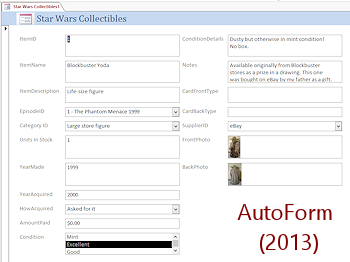
A simple autoform is very easy to create using the Form button. (This button was called AutoForm in previous versions of Access.)
There are a number of things you could do to improve the layout, but for this lesson we mostly will settle for what Access provides. Later you will learn how to change all the characteristics of a form.
Access 2007, 2010, 2013, and 2016 create very similar forms. There are some small differences in spacing between controls and the size of the controls. The form icon in the form header is different in each version. The illustrations will use Access 2010 unless there is an important difference between versions. If an image has an error, I will usually replace it with an image from my current version.
| |
Step-by-Step: Create a Form with AutoForm |
|
| What you will learn: | to create a form with AutoForm to navigate records and fields in a form in Layout and Form views to switch to Form view to use a form to add records to create a hyperlink with display text to use a form to edit records to select a record in Form View to copy a record and paste in Excel and Word |
Start with: ![]() ,
,![]() , mytrips-Lastname-Firstname.accdb from previous lesson
, mytrips-Lastname-Firstname.accdb from previous lesson
Create a Form with AutoForm
- If
necessary, open mytrips-Lastname-Firstname.accdb .
 Back up this database now.
Back up this database now.
You can use this good copy to use if you need to start over.
This works well while the database is small. Access 2007:
Access 2007:  > Manage > Back Up Database
> Manage > Back Up Database Access 2010: File > Save and Publish > Back Up Database > Save As button
Access 2010: File > Save and Publish > Back Up Database > Save As button
 Access 2013, 2016: File > Save As > Back Up Database > Save As button
Access 2013, 2016: File > Save As > Back Up Database > Save As button-
In the Navigation Pane, if necessary, click on the table Trips to select it, but do not open the table.
This table will be the source of records for the new form. -
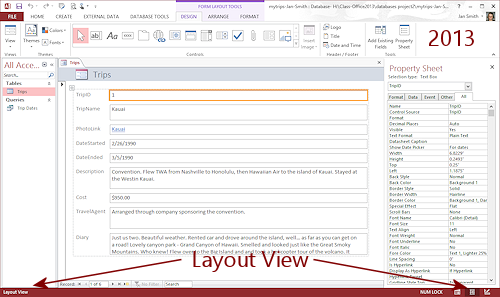 Click the Create ribbon tab and then on the Form button.
Click the Create ribbon tab and then on the Form button.


The screen may blink while Access creates the form.
The new form will open automatically to the first record in Layout View.
Layout View. Your screen may not show the property sheet.

 Save: Click the Save button
Save: Click the Save button 

 on the Quick Access Toolbar.
on the Quick Access Toolbar.
A dialog appears asking you to name the new form. Save As dialog is different: This Save As dialog is not like
the one you see in programs like Word and Excel because you
are saving your form inside the database file, not as a separate file.
Save As dialog is different: This Save As dialog is not like
the one you see in programs like Word and Excel because you
are saving your form inside the database file, not as a separate file.-
Name the form Trips AutoForm and click on OK.
Form View: Navigate Between Records
The form has the same Navigation Bar that datasheets have. You can also move through the records using the Page Up and Page Down keys on your keyboard. (The TAB, Home, and End keys move you between the controls on a form.)
 Experiment: Navigate the records
Experiment: Navigate the records
-
 Click on each of the navigation buttons in the Navigation Bar at
the bottom of the form window.
Click on each of the navigation buttons in the Navigation Bar at
the bottom of the form window. - Type in a record number and press ENTER.
-
 Press the Page Up and Page Down keys to navigate through
the records.
Press the Page Up and Page Down keys to navigate through
the records.
- Evaluate: Which method do you like best?
- Use the method of your choice to return to the first record.
- The records should be in order by TripID. If yours are not, use the Simple Solution below.
-
![]() Problem: Records out
of order or missing:
Problem: Records out
of order or missing:
The table was saved with a sort and/or filter still active. The form is using the same sort and/or filter.
Simple Solution: Start over
Close the form. Delete the form. Open the underlying table in Table Datasheet View, remove
any sorting or filters, add any sorting or filtering that you need, save the table. Recreate your
AutoForm.
If you made a lot of changes to the form before noticing the sorting and filtering, you may want to use the Advanced Solution below.
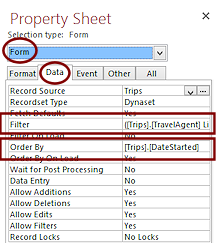 Advanced Solution: Edit Property Sheet
Advanced Solution: Edit Property Sheet
Open the form in Design View or Layout View. Show the Property Sheet for the Form.
Remove or edit the entries in the 'OrderBy' and 'Filter' properties. (This is the 'advanced' part!) Save the form again.
Changes to the table's datasheet sorting and filtering that you make after the form was created will not be used by the form automatically.
Layout View: Navigate the Fields in a Record
It is awkward to switch back and forth between the mouse and the keyboard. So how do you change from field to field with the keys?
 While in Layout View, if necessary, click on the TripID text box to select it.
While in Layout View, if necessary, click on the TripID text box to select it.
The selected control shows an orange border.- Press the TAB key to move through the form until you change
to the next record.
Since you are in Layout View, the focus moves through all of the fields and their labels. -
 Use the key combo SHIFT + TAB to move backwards through the fields to
the first field in the first record.
Use the key combo SHIFT + TAB to move backwards through the fields to
the first field in the first record.
Form View: Switch Views and Navigate Records
- Switch to Form view.
There are several ways to do that:- Ribbon:


- Statusbar:



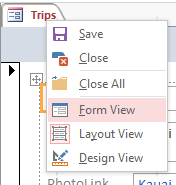 Right click menu: Right click the form's tab and choose Form View from the context menu.
Right click menu: Right click the form's tab and choose Form View from the context menu.
- Ribbon:
- Press the TAB key to move through the fields in the first record.
In Form View the focus moves only through the fields, not the labels. -
 Use the key combo SHIFT + TAB to move backwards through the fields to
the first field in the first record.
Use the key combo SHIFT + TAB to move backwards through the fields to
the first field in the first record.
![]() Tab Order: In an AutoForm
the tab order for the fields is easy to understand - straight down the one
column of fields. This is the same as the order of the fields in the table datasheet. This tab order can be changed. When you create a form
yourself or move controls around, you may need to change the tab order so that the order you wind up with is logical.
Tab Order: In an AutoForm
the tab order for the fields is easy to understand - straight down the one
column of fields. This is the same as the order of the fields in the table datasheet. This tab order can be changed. When you create a form
yourself or move controls around, you may need to change the tab order so that the order you wind up with is logical.
Form View: Add Record
Now that you can get around in the records, it's time to add some more records.
- Click on the
 New Record button on the Navigation bar.
New Record button on the Navigation bar.
A blank record appears in the form. - Type Ireland in the TripName field.
 Problem: Typing is not accepted in field
Problem: Typing is not accepted in field
You are in Layout View instead of Form View. You cannot edit or add records in Layout view.
Solution: Change to Form View. - Type or copy and paste the following data into the appropriate fields.
The Memo/Long Text fields will scroll when you reach the end of the space. Remember, you cannot enter anything in the TripID field because it is an AutoNumber field.
TripName Ireland PhotoLink DateStarted 6/4/1992 DateEnded 6/17/1992 Description Took the girls with us to convention in Ireland. Toured western Ireland. Cost $2,000.00 Travel Agent Jorge Martinez, World Travel Inc, jmartinez@worldtravelinc.net Diary Arrived at Limerick airport. Rented a car. Hit the outside mirror on a dump truck before we got out of the airport! They drive on the left in Ireland. Terrifying!!
As we drove, we kept seeing old ruined castles and abbeys. Beautiful scenery.
Took the girls to see the Blarney stone. They kissed it. You have to bend over backwards!
Had dinner at a restored medieval castle. Low doors, small rooms. Stone everywhere. Little furniture. They must not have had many clothes at all. - Press TAB or click in a different record to save your new record automatically.
Form View: Create Hyperlink with Display Text
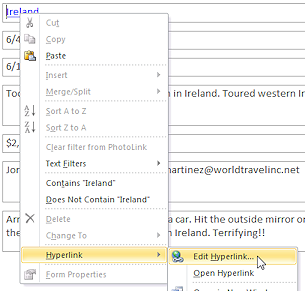 In the PhotoLink control, type Ireland. It
is formatted to look like a link, Ireland, but clicking
it won't take you anywhere. You need to edit the link.
In the PhotoLink control, type Ireland. It
is formatted to look like a link, Ireland, but clicking
it won't take you anywhere. You need to edit the link.
- Right click on the PhotoLink control and hover and then click on.
The Insert Hyperlink dialog appears. It does not matter what items show in the list of folders and files.
- Type, or copy and paste, the following URL into the Address box:
http://jegsworks.com/Lessons/images/trips/ireland/ireland.htm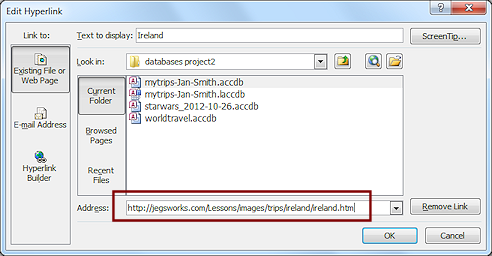
- Click on OK to close the dialog.
The link Ireland looks the same but now it actually has a destination.  Hover the mouse pointer over the link Ireland. A screen tip shows
the address that the link will take you to.
Hover the mouse pointer over the link Ireland. A screen tip shows
the address that the link will take you to. - Click in the Diary control and press the TAB key.
The form changes to the next record, which is a new blank record. - Enter the data below for yet another trip record.
As you enter text in a Memo/Long Text field, a scroll bar will appear at the far right of the text box, even if you don't need one yet.
TripName Italy PhotoLink Use Italy as the Display Text
Edit the hyperlink to use the URL below:
http://jegsworks.com/Lessons/images/trips/italy/italy.htmDateStarted 5/11/2001 DateEnded 5/21/2001 Description Toured Rome and Pompeii and Venice. Cost $6000.00 Travel Agent Hector Chavez, World Travel Inc, hchavez@worldtravelinc.net Diary Saw the Trivi Fountain, ate gelato (ice cream). Toured St. Peter's Basilica and the Sistene Chapel. Huge! Gorgeous now that most parts are restored.
Pompeii was covered in volcanic ash for centuries. Many buildings have been excavated. Painted murals and mosaics abound.
Venice has waterways for streets. Many tiny ones. Water taxis and gondolas. Did not ride a gondola. The water taxis are faster!Most people find that it is easier to enter data on a form than directly in a datasheet. What do you think?
- Save Record

 on Home ribbon tab in Records tab group.
on Home ribbon tab in Records tab group.
This button saves the current record without having to leave the record.
Form View: Edit Record
Everyone makes mistakes when entering new records. Fingers do their own thing sometimes. Even after you have carefully entered the information, it can be wrong one day. People get new phone numbers or move. Postal codes and telephone area codes change. At least it is easy enough to edit an existing record.
- If necessary, switch to the record of the Italy trip.
If you typed the information for the records accurately, you have a spelling error.
- In the Diary memo field, click in the word "Trivi" between the r
and the i.
- Press the Delete key to remove the i.
- Now type an e, so that the word
reads Trevi.
There are likely more errors in more records. Spell Check is a big help!
- Click on
 the Spelling button in the Home ribbon tab, Records tab group.
the Spelling button in the Home ribbon tab, Records tab group.
A dialog opens which will look for errors in all of the records.
The first error may be the word you just corrected! Not all words are in the Office dictionary, especially names of places and people. 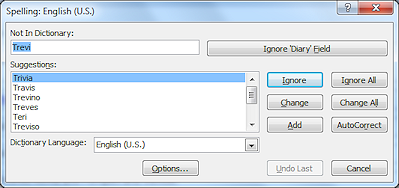 Click on Ignore for the offer to correct Trevi.
Click on Ignore for the offer to correct Trevi.
The next suggested correction is to change "Sistene" to Sistine .
-
Click on Change to accept the correction.
There are a number of corrections to make as Spell Check goes through all of the records, if you typed what you were told to type or if you copied and pasted. Yes, there were deliberate errors included!!
Some "errors" may not really be errors so read carefully what the original was and what correction is suggested.
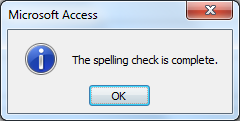 Continue until all errors are corrected.
Continue until all errors are corrected.
The dialog closes itself and pops up a message that Spelling is complete.- Click on OK.
You are back in the form. -
 Click the Save button make sure your last spelling correction is saved.
Click the Save button make sure your last spelling correction is saved.
Form View: Select Record
The record selector is much taller than in a datasheet since the fields are now arranged vertically instead of in a row.
- Switch to record #4, the Family reunion.
-
Click on the Record Selector, the tall bar at the left of the form. The bar turns black, indicating that the whole record is selected.
 Be
careful what you do while a record is selected! Deleting a record cannot be
undone.
Be
careful what you do while a record is selected! Deleting a record cannot be
undone.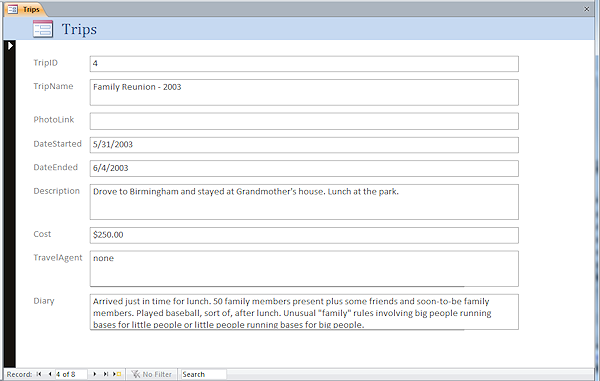
Form View: Copy/Paste Record
The only reason to select a record is to do something with it! Deleting is easy. Just press the DELETE key. Copying and pasting are easy, but you must paste to the right kind of place - another table with the correct fields in the same order or to a blank document in another program, like a spreadsheet. Copy and paste is often the easiest way to move a small number of records between programs.
- Use the key combo CTRL + C to copy the record.
-
Open Excel or another spreadsheet program to a blank spreadsheet.
-
Click in the first cell at the top and paste with the key combo CTRL + V.
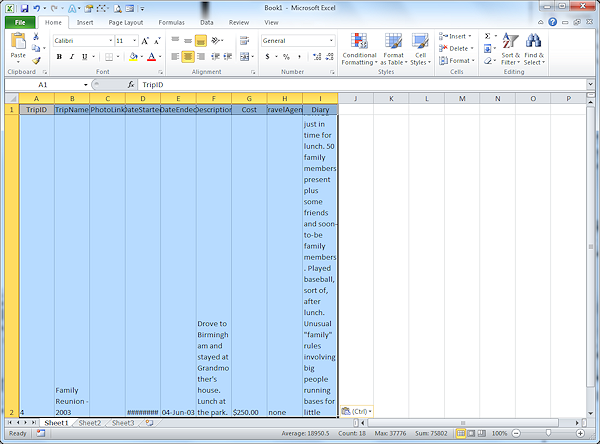
Quite a mess but easy to fix. The columns are all the same width so the Memo/Long Text fields make the row very tall.
- Close Excel without saving unless your instructor wants to see this document.
- Switch back to Access and copy the record again.
Once it was pasted, the Clipboard may have deleted it. That is common in some spreadsheets.
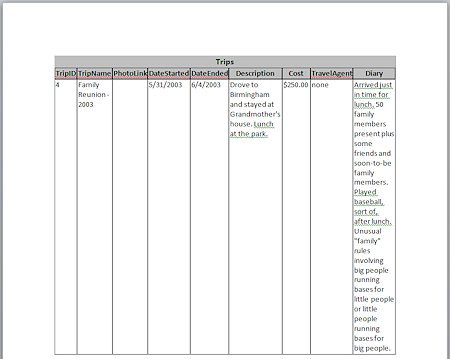 Open Word to a blank document and Paste.
Open Word to a blank document and Paste.
Word creates a table to hold the pasted record. Again, those Memo/Long Text data type fields create trouble in this kind of table.- Close Word without saving your document unless your instructor wants to see this document.
- Click somewhere in the Trips AutoForm to deselect the record.
 Back up this database now so you will have a good copy to use if you need to start over. This works well while the database is small.
Back up this database now so you will have a good copy to use if you need to start over. This works well while the database is small.
 Access 2007:
Access 2007:  > Manage > Back Up Database
> Manage > Back Up Database Access 2010: File > Save and Publish > Back Up Database > Save As button
Access 2010: File > Save and Publish > Back Up Database > Save As button
 Access 2013, 2016: File > Save As > Back Up Database > Save As button
Access 2013, 2016: File > Save As > Back Up Database > Save As button
